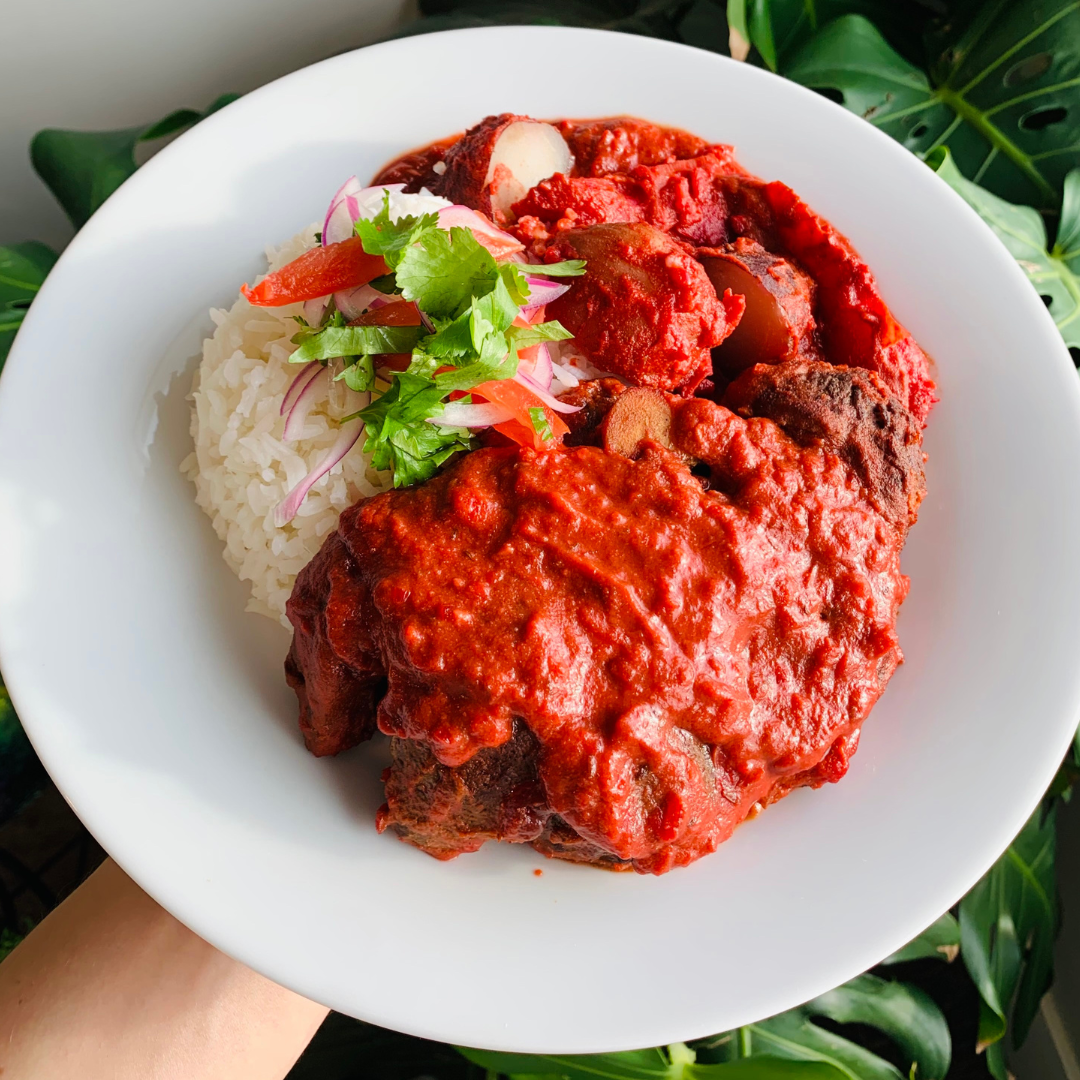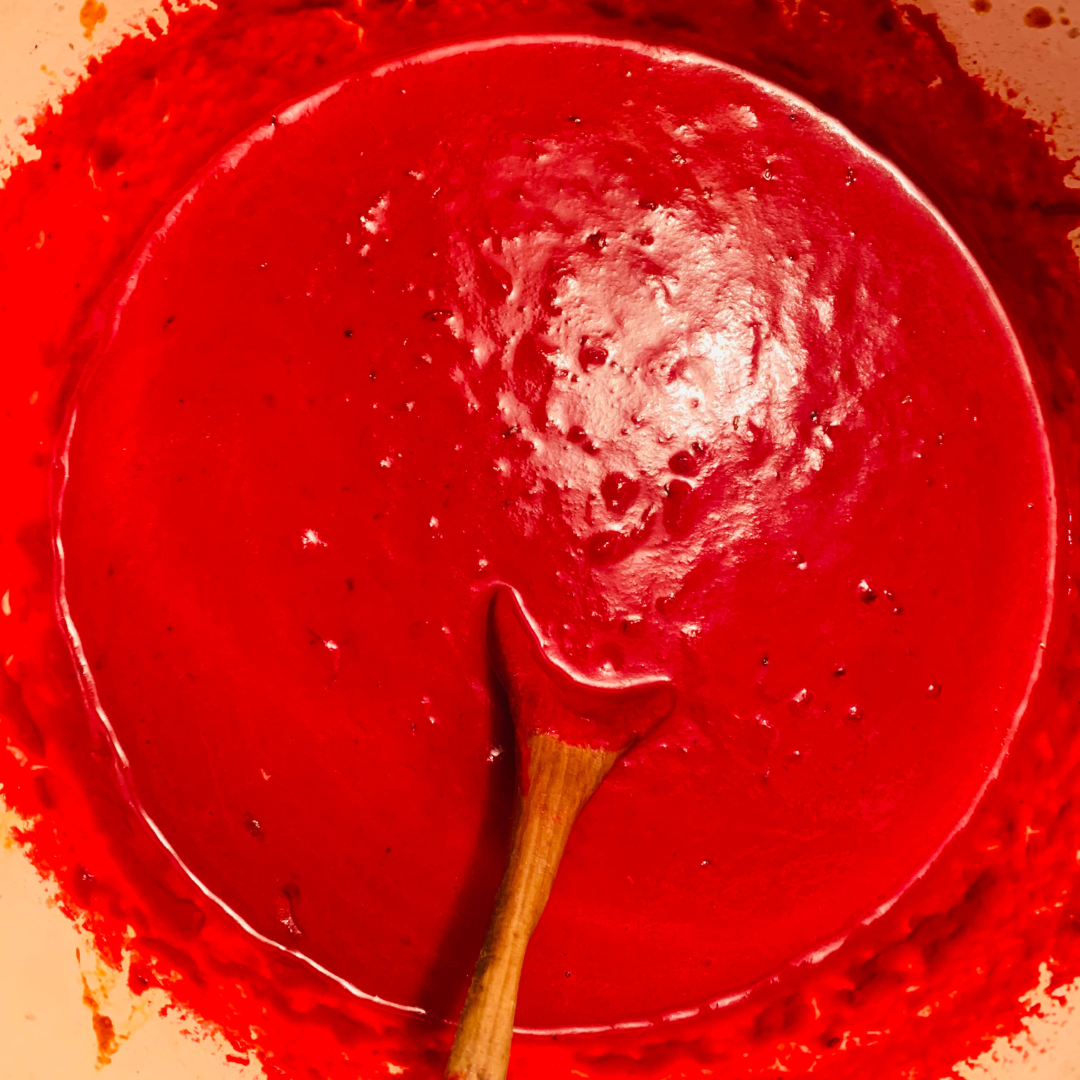Puca Picante & Coconut Carrot Curry Recipes
By: Tristan Guilbeault
Instagram: @tristangcooks
During the winter nothing is quite as good as coming home to a good hearty stew. This Peruvian-inspired stew is traditionally served for birthdays, weddings and easter celebrations but is most delicious during the peak of root vegetable season. This stew is bright, bold, and earthy, using local root vegetables, peanuts and the addition of the famous Peruvian Aji Panca. It can be made vegan or enhanced with pork, beef or chicken. This stew is a great way to use up leftover vegetables and get beets into your diet. Eat on a cold day with steamed rice and fresh herbs.
Ayacucho is a south Andean region famous for its beauty and bright colours. Puca means red in Quechwa and Picante is spicy in Spanish. So naturally this dish translates to spicy red. Traditionally the Quechwa did not use beetroot for this dish; airampo, a type of prickly pear native to the area was used instead for its bright magenta hue. As the dish evolved airampo became less common and beetroot took its place. The beet is added because it is bold but also to paint the potatoes; adding the “rojo” or “puca.” Pucu Picante represents the region of Ayocucho, the beautiful churches, squares, and clothing. I hope you enjoy my homage to the people of Ayacucho.
Puca Picante
Recipe from Tristan Guilbeault
Dietary restrictions: Keto, tree-nut-free, gluten-free, lactose-free, can be made vegan or vegetarian, paleo
Total Time: 1 hour 30 minutes | (Preparation): 30 minutes | (Cooking): 1+ hour (depends on protein)
Feeds: 4-5 people
Ingredients
● 1kg Stew beef (Gemstone or Topgrass) or beef shank, diced
chicken breast (Sunworks or Bowden) or diced pork roast blade (Broek Pork)
● 1 tbsp Avocado oil or Beef Tallow (Gemstone)
● 1 onion, minced (white or yellow)
● 4 cloves garlic, minced
● 1/4 cup Aji Panca or Chipotle Peppers (Dos Amigos)
● 1 tsp cumin, whole or ground
● 1⁄2 cup toasted peanuts
● 1 beet, roasted
● 500g fingerling potatoes
● 500g carrots or parsnips
● 2 Roma tomatoes, chopped
● 2 cups stock (Chicken, beef or vegetable)
● Salt and pepper to taste
Salsa Criolla
● 1 Roma tomato, seeds removed, cut julienne
● 1⁄2 small red onion, cut julienne
● 1⁄4 cup roughly chopped cilantro
Instructions
1. Set the oven to 400 degrees. Season a beet with oil and salt, cover in aluminum foil and cook for 30 minutes.
2. Add 1 tablespoon of oil to a large pot or Dutch oven on medium heat. Season the protein liberally with salt. Sear on all sides, for 1-2 minutes, flipping when they have gained some colour. Sear all pieces and set aside.
3. Add diced onions to the pot and stir continuously for 2 minutes. Reduce heat to medium-low. Add garlic. Continue cooking for 7 minutes, stirring occasionally. Add cumin, Aji Panca, salt, pepper and chopped tomatoes. Increase heat back to medium, let tomatoes release their juice and the sauce to reduce, about 10 minutes, stir as necessary.
4. Take a pan and bring to medium heat, add peanuts. Stir continuously until peanuts are fragrant and have gained some colour, 5 minutes or less. Once the beet is done cooking, remove it from the foil. If using beef shank, turn down the oven to 325. Once beet can be handled, roughly cut and add to a blender. Add toasted peanuts and 1 cup water, or more to blend. Once blended until smooth, add to the pot along with the stock. Season with salt.
5. Cut the root vegetables, they need to be kept large. If using fingerlings; the small ones can be left whole and the larger ones can be cut in half. Carrots and parsnips can be cut into large chunks using a rolling cut or cut into coins lengthwise. Add the shanks to the bottom of the pot and place in the middle rack of a 325 degree oven. After 1 hour add the root vegetables. Ensure everything is submerged, if not add more stock.
6. Let the mixture braise for 1 more hour, less or more depending on the meat used. Once done, remove from oven and let rest for 15-20 minutes.
7. Serve over steamed rice with salsa criolla and enjoy!
*If you are using chicken or pork, skip the oven. Add the vegetables to the pot and simmer on medium-low for 30 minutes. Add the seared meat and cook until both vegetables and meat are cooked through, another 20-30 minutes. Turn the heat off and let the stew sit for 15 minutes to let the flavours meld.
Aji Panca
Aji Panca is a sweet, mild, smoky chili that is used in Peruvian dishes to provide base and depth. Spice-wise it is comparable to a mild poblano chili, or half the strength of a jalapeno. The flavour itself is subtle and can be found in a myriad of soups, stews and other dishes in Latin America. Here in Calgary it is not sold at the grocery store but can be found in Latin stores and spice markets. The jarred paste can be found at Unimarket, while whole and dried Aji Panca can be found at Silk Road Spice Merchant in Inglewood, as well as Spice Merchant online. These whole chilis or powder can be blended with water until a paste forms and used as is. Now because this is a specialty ingredient, I understand only some have the time to drive around for a spice, so in my personal opinion, the best substitution flavour-wise would be chipotle in adobo. Canned chipotle peppers will provide a similar smoky profile with more spice, Amaranth sells them and they will make a delicious stew, although it is not the same as Aji Panca.
Substitutions
This recipe at its base is a luscious vegan stew, it can be complimented and made richer with the addition of beef, chicken or pork. Tougher cuts like shank and chuck roast will work, they just require longer to braise. Pork shoulder, pork belly, and chicken breasts on the other hand require less cooking time but are more traditional in Peru. As for vegetables, any root vegetables may be used. Amaranth carries beautiful red and golden beets, purple potatoes, yellow potatoes, red potatoes, lovely parsnips, and sweet carrots; which would all be fantastic in this dish. This dish is hearty, healthy and nutritious and can be made depending on you and your family's preferences. Please enjoy my take on Pucu Picante!
This simple creamy luscious soup is fantastic during the winter season. It's now getting colder here in Calgary and it can be hard to find the energy to go out. Luckily this soup is easy to make and is a great way to use up excess carrots or vegetables you may have. The flavours are inspired by Indian and Peruvian cuisine, it’s hearty, bold, flavourful, nutritious and it can enhanced by your favourite spices. Serve it with your favourite grilled cheese, garnished with toasted nuts, cilantro and even a splash of hot sauce. It is an amazing comfort meal that is vegan as well!
Coconut Carrot Curry
Recipe from Tristan Guilbeault
Dietary Restrictions: paleo, keto, lactose-free, gluten-free, can be made nut-free, can be made vegan or vegetarian
Total Time: 1 hour | (Preparation): 15 minutes | (Cooking): 45 minutes
Feeds: 4-5 people
Ingredients
● 900g Organic carrots (Leffer Brothers)
● 2 small onions, minced (white or yellow)
● 1 tbsp garlic minced
● 1 tsp ginger minced
● 2 tbsp maple syrup
● 14oz can of coconut milk
● 1 tbsp curry powder
● 1 tsp cumin
● 1 tsp salt
● 2 tbsp olive oil or avocado
● 2 cups vegetable or chicken broth
Garnish (Optional)
● 1⁄4 cup toasted almonds, peanuts, pumpkin seeds or cashews
● 1 tsp chipotle powder, five-spice, or curry powder
● 1⁄4 cup cilantro leaves
● 1 lime, cut in quarters
Instructions
1. Begin by cutting the carrot into coins, as well as mincing the garlic, onion and ginger.
2. Set a medium-sized pot on medium heat. Add the oil then the ginger and garlic. Cook until both are fragrant about 2 minutes. Add the onions, turn down the heat to medium-low and let sweat for about 8 minutes, stirring as necessary. Now add the spices. Let them toast in the oil and stir to combine them with the aromatics, around 2 minutes. Deglaze the pot with the broth, scraping any browned bits off the bottom, add the carrots and the coconut milk. Turn back up to medium heat, and let simmer until carrots are tender around 30 minutes. Make sure to stir occasionally as the sugar from the coconut milk can caramelize on the bottom!
3. Once carrots are tender, blend using a hand or stand-up blender until smooth. Add back to the pot, add maple syrup as well as salt and pepper to season. At this stage, check if the soup is too thick, if so add more broth until a creamy consistency is achieved.
4. Now take your nuts and add a teaspoon of oil. Add preferred spice, and season lightly with salt, mix until coated. Toast them in a pan on medium heat until crisp and fragrant. Around 5 minutes.
5. Serve the soup, garnish with the toasted nuts, cilantro, a squeeze of lime, a hit of hot sauce, and serve alongside a perfect vegan grilled cheese (recipe below). Enjoy!
Vegan Grilled Cheese
Ingredients
● 2 slices of local bread (Homestead Bread, or Eats by Cole)
● 1 tbsp coconut oil
● 1 tsp nutritional yeast (Bragg, or Westpoint)
● Preferred vegan cheese, shredded or slices (Daiya, Field Roast Chao, Parmela Creamery or Nafsikas Garden)
Instructions
1. Spread the coconut oil on both sides of the bread, add to a pan on medium heat and cook until golden brown, around 5 minutes. Flip the bread over and add your choice of cheese, add the nutritional yeast and put the two pieces together. Continue to cook until the outside is golden brown and the cheese is gooey, another 5 minutes.
2. Dip in the coconut carrot curry soup and enjoy!
* Add a tablespoon or two of Wildbrine Korean Kimchi for an extra hit of flavour!
substitutions
This recipe serves as a great base for any root vegetable to be turned into a delicious creamy nutritious soup. Amaranth carries sweet potatoes, parsnips, celeriac and butternut squash all of which would be delectable in this recipe. The flavour profile of this soup can be bumped up as well; 1 tsp chili powder or chipotle can be added for spice, 1 tsp cinnamon can be added for a warmer flavour and 1 tsp five-spice can be used for an Asian twist. This recipe is vegan but the protein content can be bumped up by adding canned Eat Wholesome lentils or Eden Organic chickpeas. Add broth accordingly, about 1 cup broth for 1⁄2 cup lentils.
STORAGE
This recipe can be kept well in the fridge for up to ten days and kept in the freezer for up to three months. It is a great soup to meal plan and freeze for the upcoming cold months. Please enjoy!










